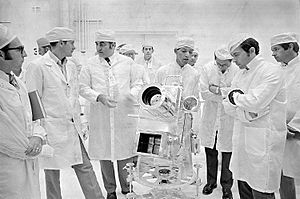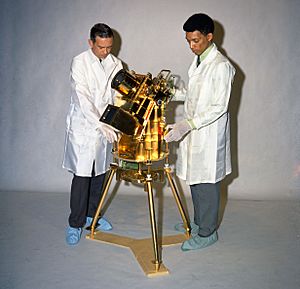George Robert Carruthers facts for kids
Quick facts for kids
George Robert Carruthers
|
|
|---|---|

George Carruthers (center) discusses the Lunar Surface Ultraviolet Camera with Apollo 16 Commander John Young (right). Also pictured are Lunar Module Pilot Charles Duke and Rocco Petrone, Apollo Program Director.
|
|
| Born | October 1, 1939 Cincinnati, Ohio, U.S.
|
| Died | December 26, 2020 (aged 81) Washington, D.C., U.S.
|
| Nationality | American |
| Alma mater | University of Illinois at Urbana-Champaign |
| Known for | Invention of the ultraviolet camera/spectrograph |
| Awards | Arthur S. Flemming Award, 1970 National Medal of Technology and Innovation, 2011 |
| Scientific career | |
| Fields | Physics |
| Institutions | United States Naval Research Laboratory |
| Thesis | Experimental investigations of atomic nitrogen recombination (1964) |
George Robert Carruthers (born October 1, 1939 – died December 26, 2020) was an amazing American space physicist and engineer. He was famous for creating a special ultraviolet camera/spectrograph. This powerful camera was used by NASA during the Apollo 16 mission in 1972. Carruthers's work helped us understand space much better. He was recognized for his inventions and inducted into the National Inventors Hall of Fame in 2003. In 2011, he received the National Medal for Technology and Innovation, a very high honor.
Contents
Early Life and Education
George Carruthers was born in Cincinnati, Ohio, on October 1, 1939. He was the oldest of four children. His father was an engineer, and his mother managed their home. From a young age, George loved space. He read many science fiction stories about space travel. His father also encouraged his interest in math and science.
When he was just 10 years old, George built his first telescope. He used cardboard tubes and lenses he bought with money from his delivery job. Even though he struggled with some subjects in elementary school, he won three science fair awards!
When George was 12, his father passed away. His family then moved to Chicago, where they lived with relatives. George loved visiting Chicago's museums, libraries, and the Adler Planetarium. After the first satellite, Sputnik, was launched, he became very interested in model rockets. He joined the Chicago Rocket Society and other science clubs.
After high school, George went to the University of Illinois at Urbana–Champaign. He earned a Bachelor of Science degree in physics in 1961. He continued his studies there, getting a master's degree in nuclear engineering in 1962. In 1964, he completed his Ph.D. in aeronautical and astronautical engineering. His Ph.D. research focused on how atomic nitrogen recombines.
In 1964, George Carruthers joined the United States Naval Research Laboratory. He started as a special postdoctoral fellow. Later, in 1967, he became a permanent scientist in the Space Science Division.
In 1966, Carruthers invented an image converter. This device could turn images made from very short wavelengths of light into electron images. It was a big step forward because it could capture a full spectrum of light in one go. This invention was also tougher than older ultraviolet films. In its first test flight in 1970, it detected molecular hydrogen in space for the first time! This helped scientists understand the "missing mass" problem in space.
In 1969, NASA asked for ideas for experiments on future moon missions. George Carruthers and another scientist, Thornton Page, both suggested using ultraviolet imaging of Earth. NASA asked them to work together. Carruthers became the main scientist and chief engineer for the project.
On April 20, 1972, the Apollo 16 mission landed on the Moon. It carried the Far Ultraviolet Camera/Spectrograph designed by Carruthers. This was the first telescope ever set up on another planet! It was a larger, gold-plated version of his earlier image converter. Astronaut John Young set up the telescope. He and Charles Duke collected data by pointing it at Earth and other targets. They took almost 200 images, including amazing pictures of Earth's polar auroras.
Carruthers's cameras were also used for other important projects. They captured ultraviolet images of famous comets like Halley's Comet and Comet Kohoutek. In 1991, he created a camera for the STS-39 Space Shuttle mission. He also continued studying polar auroras with an instrument called the Global Imaging Monitor of the Ionosphere, launched in 1999 on the ARGOS (satellite).
Carruthers retired from the Naval Research Laboratory in 2002. He was a senior astrophysicist.
In 2009, he was honored as a distinguished lecturer for his work in space science. On February 1, 2013, President Barack Obama gave him the National Medal of Technology and Innovation. This award recognized his invention of the Far UV Electrographic Camera. It greatly improved our understanding of space and Earth.
Outreach Work and Inspiring Others
George Carruthers was passionate about helping young people learn about science. In the 1980s, he helped create a program for high school students. This program allowed them to work with scientists at the Naval Research Laboratory during the summer. He also supported many science education activities in the Washington D.C. area.
In 1996 and 1997, he taught a course for science teachers in D.C. public schools. He also helped make educational videos about Earth and space science for high school students.
Carruthers worked hard to encourage African Americans to get involved in science and technology. He was part of groups like Project SMART and the National Society of Black Physicists. He often participated in public events at Howard University and the National Air and Space Museum.
From 1983, he was the editor of the Journal of the National Technical Association. This journal shared stories about important African American scientists and engineers. It was sent to high schools and colleges.
After retiring, Carruthers taught Earth and space science at Howard University. This course was supported by a NASA grant.
Death and Lasting Legacy
George Carruthers passed away on December 26, 2020, in Washington D.C. He left behind an incredible legacy.
In 2022, NASA honored him by renaming a mission after him. The Global Lyman-alpha Imager of the Dynamic Exosphere mission (GLIDE) became the Carruthers Geocorona Observatory. This mission is scheduled to launch in 2025. It will observe Earth's atmosphere using ultraviolet light, continuing the kind of work Carruthers pioneered. The renaming ceremony happened on December 2, 2022, at his old university, the University of Illinois at Urbana-Champaign.
Honors and Awards
- 1970 Arthur S. Flemming Award
- 1972 NASA Exceptional Scientific Achievement Medal
- 1973 Helen B. Warner Prize for Astronomy of the American Astronomical Society
- 1987 Black Engineer of the Year Award
- National Science Foundation Fellow
- Honorary Doctor of Engineering, Michigan Technological University
- 2003 Inducted into the National Inventors Hall of Fame
- 2012 National Medal of Technology and Innovation


